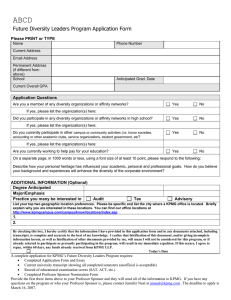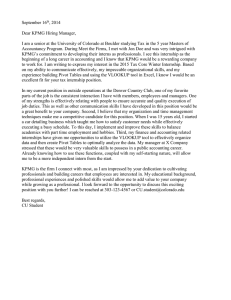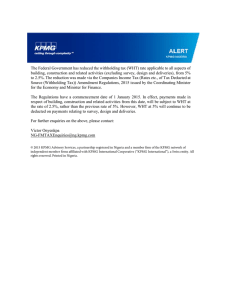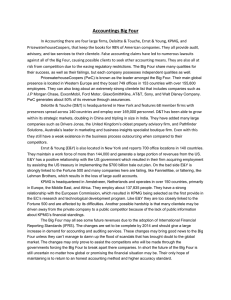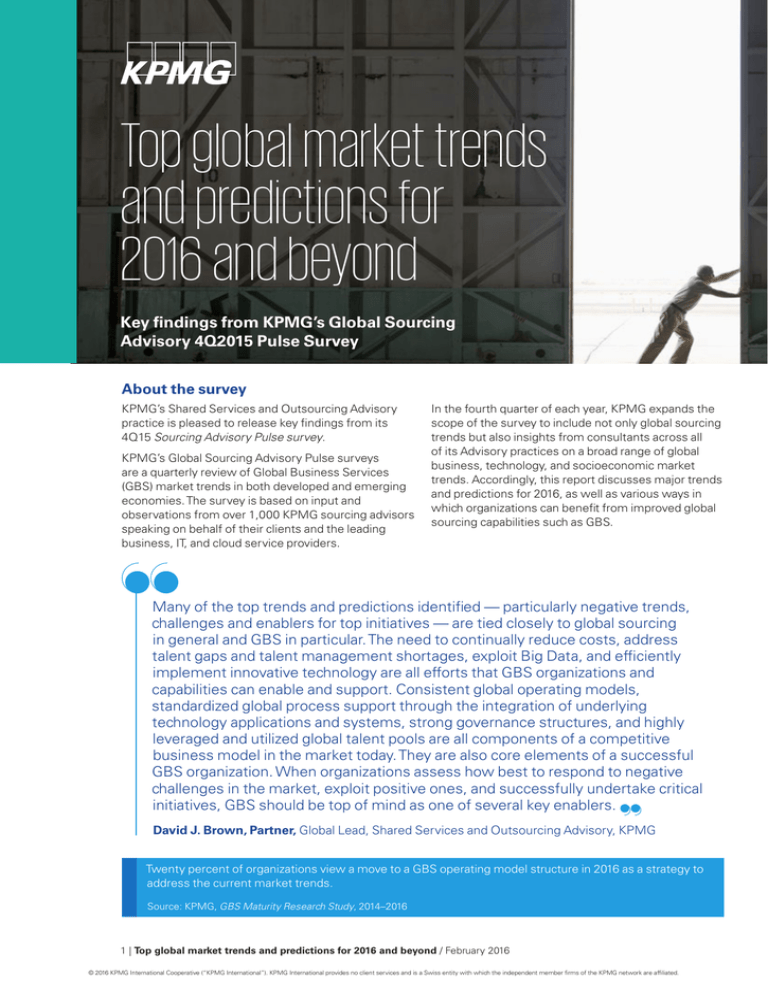
Top global market trends
and predictions for
2016 and beyond
Key findings from KPMG’s Global Sourcing
Advisory 4Q2015 Pulse Survey
About the survey
KPMG’s Shared Services and Outsourcing Advisory
practice is pleased to release key findings from its
4Q15 Sourcing Advisory Pulse survey.
KPMG’s Global Sourcing Advisory Pulse surveys
are a quarterly review of Global Business Services
(GBS) market trends in both developed and emerging
economies. The survey is based on input and
observations from over 1,000 KPMG sourcing advisors
speaking on behalf of their clients and the leading
business, IT, and cloud service providers.
In the fourth quarter of each year, KPMG expands the
scope of the survey to include not only global sourcing
trends but also insights from consultants across all
of its Advisory practices on a broad range of global
business, technology, and socioeconomic market
trends. Accordingly, this report discusses major trends
and predictions for 2016, as well as various ways in
which organizations can benefit from improved global
sourcing capabilities such as GBS.
Many of the top trends and predictions identified — particularly negative trends,
challenges and enablers for top initiatives — are tied closely to global sourcing
in general and GBS in particular. The need to continually reduce costs, address
talent gaps and talent management shortages, exploit Big Data, and efficiently
implement innovative technology are all efforts that GBS organizations and
capabilities can enable and support. Consistent global operating models,
standardized global process support through the integration of underlying
technology applications and systems, strong governance structures, and highly
leveraged and utilized global talent pools are all components of a competitive
business model in the market today. They are also core elements of a successful
GBS organization. When organizations assess how best to respond to negative
challenges in the market, exploit positive ones, and successfully undertake critical
initiatives, GBS should be top of mind as one of several key enablers.
David J. Brown, Partner, Global Lead, Shared Services and Outsourcing Advisory, KPMG
Twenty percent of organizations view a move to a GBS operating model structure in 2016 as a strategy to
address the current market trends.
Source: KPMG, GBS Maturity Research Study, 2014–2016
1 | Top global market trends and predictions for 2016 and beyond / February 2016
© 2016 KPMG International Cooperative (“KPMG International”). KPMG International provides no client services and is a Swiss entity with which the independent member firms of the KPMG network are affiliated.
#1 2015 52%
Weak global/regional economies
51%
67%
#3 2015
58%
#1 2015
35%
Weak consumer/customer demand
50%
16% Y/Y
32%
Political/government gridlock
37% Y/Y
17%
21% Y/Y
28%
Repressive rules and regulatory regimes
21% Y/Y
58%
33%
Geopolitical; terrorism; war on terror
Service providers
Talent shortages & challenges
Advisors
2016 trends with biggest negative impact on user organizations
33%
0%
50%
100%
0%
50%
100%
Source: KPMG’s Global Sourcing Advisory 4Q2015 Pulse Survey
Talent challenges
As in 2014 and 2015, survey respondents were most
concerned about talent shortages and talent management.
This was especially the case with advisors supporting global
efforts and those operating in North and South America. These
concerns were accompanied by the prospect of continued
weaknesses in global economies and certain consumer
markets.
If organizations don’t have the right talent,
they can’t exploit the new technologies
required to address such initiatives as
Big Data.
These challenges — and especially those involving talent —
are not cyclical and will not diminish any time soon. They are a
“new norm” and any organization’s strategic and operational
plans and models must address them.
Stan Lepeak, Global Research Director,
Management Consulting, KPMG
It is also highly likely that negative geopolitical events,
political gridlock, and overregulation will continue to grow as
challenges, often in an intertwined manner, and thus must
also be factored into business strategies and models.
#1 2015
62%
5% Y/Y
44%
Improving consumer/customer demand
The ability to tap into skilled global
talent pools
34%
Improving/rebounding global
economic conditions
34%
Expanding emerging market opportunities
for selling goods/services
32%
0%
#1 2015
58%
50%
12% Y/Y
42%
50%
Service providers
Maturation of/greater access to
innovative technologies
Advisors
2016 trends with biggest positive impact on user organizations
42%
50%
100%
0%
50%
Source: KPMG’s Global Sourcing Advisory 4Q2015 Pulse Survey
2 | Top global market trends and predictions for 2016 and beyond / February 2016
© 2016 KPMG International Cooperative (“KPMG International”). KPMG International provides no client services and is a Swiss entity with which the independent member firms of the KPMG network are affiliated.
100%
Technology enablement
In short, technology enablement will include both benefits
and challenges related to change management, organizational
structuring, and even political and socioeconomic
developments as firms, markets, and governments address
a potentially massive shift in what is needed to support a
competitive and sustainable workforce.
This year’s top positive trends once again include the use of
innovative technology and the increased ability to leverage
pools of highly skilled talent on a global basis. There is a great
deal of potential for organizations that can successfully exploit
innovative technologies such as Big Data, Robotics Process
Automation (RPA), and the cloud.
However, for many organizations, technology-based
innovation is still very much a work in process — and for some
only wishful thinking. Early-stage planning and development is
not the same as implementation.
Organizations need skilled talent on the back
end for implementation, but they also need
front-end support from information architects
to help guide the technology investment
toward bottom line results.
For example, Big Data can make organizations much smarter
in their decision-making, but only if they have the talent
to manage, interpret, and then apply this data to business
problems. Leveraging Big Data usually requires a significant
upgrade in skills in both the business and IT sides of the
organization. In the same way, RPA holds great potential
over the long term to improve process efficiencies and lower
operating costs, but high-end RPA is still in its infancy, and
new skills are required to operate and exploit RPA platforms.
Stan Lepeak, Global Research Director, Management
Consulting, KPMG
#1 2015
72%
56%
Invest in new/improve information technology
Redesign/reengineer core business processes
92%
17%
54%
Deliver new/innovative products/
services into market
39%
Optimize global service delivery
chains; excel at GBS
31%
Find, attract and retain talent globally
30%
0%
75%
#1 2015
58%
Service providers
Continue to drive down operating costs
Advisors
Top 2016 user organization initiatives
67%
33%
50%
100%
0%
50%
100%
Source: KPMG’s Global Sourcing Advisory 4Q2015 Pulse Survey
Cost reduction
In today’s business environment, cost reduction is more than
just squeezing suppliers or shaving a few percentage points from
expenses. Organizations have to spend money to save money.
This is the central paradox shown by the chart above.
Although the top initiative is about driving down costs, the
next three require expenditures to execute, especially the
second initiative (investing in new technologies) and the fourth
(delivering innovation). To cost-justify these expenditures,
organizations must invest in ways that help ensure quick wins
and relatively short payback periods.
Some examples of this include migrating existing applications
to the cloud, jettisoning costly legacy systems, adopting new
cost-efficient technology, and working with business partners
to share costs. The key point is to remain realistic and make
sure all relevant parties including business units, IT, and
management are in sync with their plans and goals.
3 | Top global market trends and predictions for 2016 and beyond / February 2016
© 2016 KPMG International Cooperative (“KPMG International”). KPMG International provides no client services and is a Swiss entity with which the independent member firms of the KPMG network are affiliated.
Smart/innovative management and
management practices
11% Y/Y
#1 2015 53%
The ability to find, attract and retain
talent globally
27%
46%
36%
44%
36%
39%
IT systems and capabilities beyond cloud
36%
36%
Alternative service delivery models
30%
Global business services
#1 2015
55%
64%
26%
Cloud computing
Service providers
56%
Business intelligence/harnessing Big Data
Advisors
Top capabilities required to successfully undertake 2016 initiatives
0%
50%
100%
0%
50%
26% Y/Y
100%
Source: KPMG’s Global Sourcing Advisory 4Q2015 Pulse Survey
The 2016 plan — challenges and required capabilities
Large, global organizations often struggle to be nimble.
They need seasoned executives and staff resources to take
advantage of the latest and greatest technology. But worldwide
demographics, inadequate educational systems, and the
changing tastes of millennial workers mean that talent shortages
and the war for talent are here to stay. Addressing these points
requires organizations to ask the hard questions — How to shake
up talent and talent management models to better find, train,
and nurture resources? How to identify and reduce the number
of underperformers? And, if organizations want to invest in new
technologies such as RPA, is the right talent in place to support
these investments?
In terms of capabilities required to successfully undertake
2016 initiatives, Big Data rose to the top this year, and the
recurring theme of talent increased in importance. Big Data
has great potential, but it is more about having the people to
exploit it than the technology itself.
Five key takeaways
— The current war for talent is not part of a business
cycle but rather the new norm for global organizations.
The same can be said for the continued importance of
innovative technology.
— Talent and technology are intertwined — organizations
will need tech-savvy workers who have the analytic
capabilities, background, and training to take advantage
of today’s technology.
— Organizations will have to spend money through
technology investments to save money through systems
that are more cost-efficient.
— Organizations will need to be realistic and focused in
their selection of new technology and markets.
— Big Data/Business Intelligence will be the most
important technological enabler required to successfully
undertake 2016 initiatives.
To learn more about KPMG’s 2016 sourcing trends and predictions, and the impact of or potential strategies for response, please contact:
David J. Brown
Global Lead, Shared Services and Outsourcing Advisory
T: +1 314 803 5369
E: djbrown@kpmg.com
kpmg.com/socialmedia
kpmg.com/app
The information in this email is confidential and may be legally privileged. It is intended solely for the addressee. Access to this email by anyone else is unauthorized. If you are not the intended recipient,
any disclosure, copying, distribution or any action taken or omitted to be taken in reliance on it, is prohibited and may be unlawful. When addressed to our clients any opinions or advice contained in this
email are subject to the terms and conditions expressed in the governing KPMG client engagement contract.
© 2016 KPMG International Cooperative (“KPMG International”), a Swiss entity. Member firms of the KPMG network of independent firms are affiliated with KPMG International. KPMG International
provides no client services. No member firm has any authority to obligate or bind KPMG International or any other member firm vis-à-vis third parties, nor does KPMG International have any such
authority to obligate or bind any member firm. All rights reserved.
The KPMG name and logo are registered trademarks or trademarks of KPMG International.
Designed by Evalueserve | Publication name: Top global market trends and predictions for 2016 and beyond | Publication number: 133175-G | Publication date: February 2016

